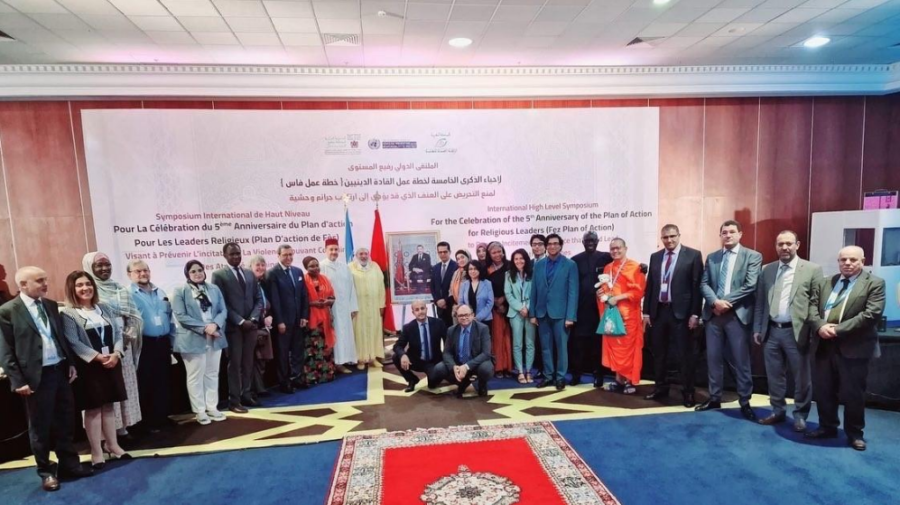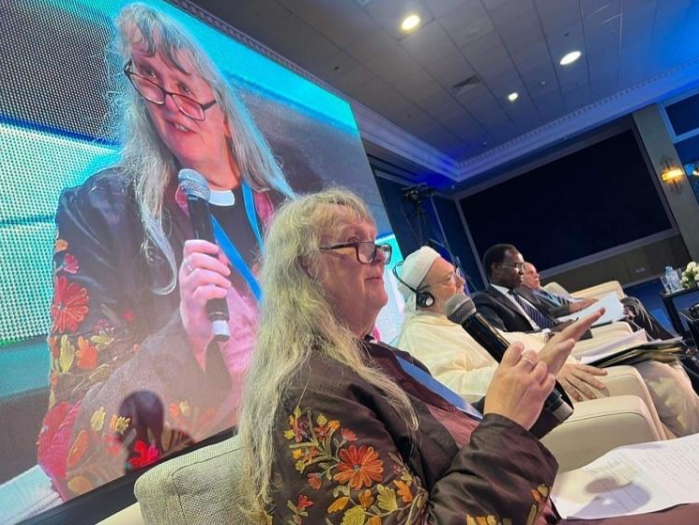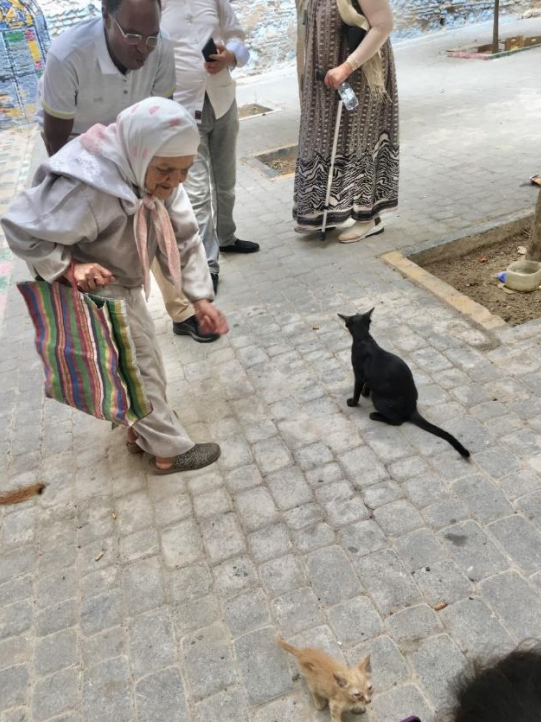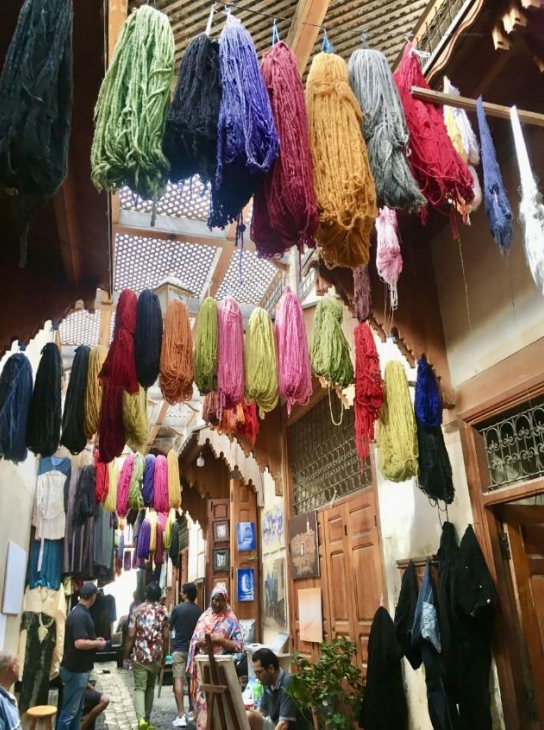Celebration of the Fifth Anniversary of The Fez Plan of Action – a Global Plan of Action for Religious Leaders & Actors for Ending Incitement to Atrocity Crimes
Celebration of the Fifth Anniversary of The Fez Plan of Action – a Global Plan of Action for Religious Leaders & Actors for Ending Incitement to Atrocity Crimes
by Reverend Bonnie Evans-Hills,
Priest in Charge, Church of St. Margaret, Queen of Scotland, Leven, Fife
 Photo courtesy of the UN Office
Photo courtesy of the UN Office
As stated in the opening to the most recent concept note by the UN: ‘The UN Office on Genocide Prevention and the Responsibility to Protect (OSAPG) works to advance national and international efforts to protect populations from genocide, war crimes, ethnic cleansing, and crimes against humanity (atrocity crimes), as well as their incitement. OSAPG collects information, conducts assessments of situations worldwide and alerts the Secretary-General and relevant actors to the risk of atrocity crimes, as well as their incitement.’ Following two years of regional consultations, the above-named Plan of Action was launched at the UN in New York in 2017. Rev Bonnie Evans-Hills took part in the European consultation in 2015, and organised a UK consultation in Luton in 2016, following the post-Brexit referendum spike in hate crime. Follow-up consultations were held in order to feedback developments and to enable collaboration across regions. Bonnie spoke at each of these meetings.
What follows is Bonnie’s summary of her contributions and insights from the latest consultation, held in Fez, Morocco in July 2022. She was asked to speak on two panels: 1 – The Role of Religious Leaders in fostering peaceful, inclusive and just society; and 3 – The gender dimension of the Fez Plan of Action: the role of women and youth of faith.
Panel 1
- The role played by religious leaders in promoting peace and social
inclusion. - Available resources and tools that enable religious leaders to contribute
and enhance their role in societies. - Challenges and gaps face by religious leaders and ways to address them.
I’d like to run through a few observations from the past few years. Following the launch in New York of the Global Plan, another gathering was held in Vienna to follow up on developments. Coming from the UK, and following the spike in hate crime after the Brexit referendum, I stated that for religious and humanitarian leaders, Brexit did not exist – we recognised the importance of continuing to collaborate across national borders. And we have continued to endeavour to do so.
But we do have to acknowledge those borders exist, and are there for a purpose, much of which is reasonable. However, borders can also be a rallying point for radicalisation of far right nationalism, and those who wish to block humanitarian efforts at providing assistance for those seeking safe refuge and asylum. Despite this, both religious and civil society organisations continue to work together to support and aid those fleeing war and violence.
A few weeks ago, the UK hosted an International Ministerial of Freedom of Religion or Belief (FoRB), with visitors from all over the world. Now FoRB sounds an excellent agenda for leaders of religion and belief to collaborate with governments. And for the most part I agree – but that agreement comes with caution. FoRB is one article in the Universal Declaration of Human Right, none of which were intended to be separated out. They are meant to function in balance. Sadly, there have been some elements among our more conservative colleagues who have sought to use FoRB as a means of justifying continued exclusion of certain groups – to do with gender, race, sexuality, or even other religions or those within their own tradition but who hold differing views. All freedoms come with responsibility – to ensure the rights of others are not negatively affected by our actions. We are free to believe what we like, but not to act or express it in a way that would adversely affect the lives and rights of others. So while this engagement with FoRB sounds basically good, it must come with this caution.
Over the Covid lockdowns I have witnessed two very different responses from government and religious institutions. In Scotland, the First Minister and the already established group of faith leaders (with Interfaith Scotland acting as secretariat) consulted one another in developing guidelines. In England, it was much more chaotic, no such forum exists for collaboration and many faith communities struggled with interpreting and implementing lockdown rules.
During the Black Death/Plague in Europe circa 1517, Martin Luther wrote, “Therefore I shall ask God to mercifully protect us. Then I shall fumigate, help purify the air, administer medicine, and take it. I shall avoid places and persons where my presence is not needed in order not to become contaminated and thus infect and pollute others, and so cause their death as a result of my negligence.”
Understandably, the pandemic caused much confusion, much the same as at the time of Luther. Some went out to minister and ended up being superspreaders, and some closed down or ran away. But crises can also bring out the best in people. Communities and businesses collaborated in ensuring people were fed, cared for, children and families supplies with tablets and internet in order to ensure continued access to education. Rabbi Jonathan Sacks, in his book Dignity of Difference, wrote of how single, cash crops, can be devasted by a single disease or pest. The whole crop wiped out. But where there is diversity, there is survival. When one crop is wiped out, others remain, and the people are fed. The same is true for diversity within communities – there is a health in difference. And we know the same is true for the environment, a diverse environment is a healthy one.
A third generation forester from Canada, Susanne Simard, writes of something similar in her book Finding the Mother Tree. That diversity in forests mean what brings strength to one type of tree in one season can bring weakness in another. Those in seasons of strength share nutrients with weaker trees through tiny rhizomes and roots under the earth, times of strength changing with the change of season. They each survive due to their shared collaboration.
Throughout these conferences we have heard many varied stories, but in the end, they are all about building relationships in local communities. Collaboration on local levels, the strong helping the weak, helps break down suspicion and hate. Collaboration with government is part of participation in democracy. But it remains wise to any political agenda. Good participation also means speaking truth to power, even when it is uncomfortable.
 Photo courtesy of the Venerable Napan
Photo courtesy of the Venerable Napan
Panel 3
- How can women and youth of faith contribute to implement the Fez Plan
of Action? - What are the main obstacles they face?
- How can these challenges be addressed? What resources can the
international community provide to advance this issue? - The role of the digital community in implementing the Fez Plan of Action Plan (particularly influencers and social media channels)
There is a living memory where I grew up, in the United States, of segregation. And even more recently for those where there has been apartheid, such as South Africa. What this meant was that those who had darker skin were barred from attending certain schools, or even getting an education. They couldn’t go certain places, couldn’t go into restaurants, or concerts, or shops. They couldn’t ride the bus or even use certain drinking fountains for water. Racism still exists. I must acknowledge that my own skin colour gives me certain advantages. But at the same time, there are places I am not allowed to go, things I cannot
participate in, because I am a woman.
While there has been good intention behind providing special programmes for women and young people, the question does need to be asked: how to empower excluded groups without adding to that exclusion? Because sometimes in setting up these programmes, we are still setting them aside – keeping them out of the main agenda in the name of empowering them.
In one of my former churches, a group of us listened to a young teenager explain that she wanted to be part of the church because she wanted to be part of a community. She didn’t want to be set aside in a group called ‘youth’, she wanted to be a part of the wider community, to worship together, and not be sent out.
A number of indigenous cultures include all, old and young, in their ceremonies, in their storytelling, in their day to day activities in growing food or hunting on the land, going out to sea, in the arts, in their sharing of songs. The generations, women and men, old and young, come together. There is a rhetoric that justifies education of women and girls because they are the ones who raise the next generation. But no, children are not raised by a woman alone in a house. It takes a village, a community, to raise a child.
During the 2016 UN World Humanitarian Summit, the importance of including women and young people at all levels was repeatedly emphasised. Both are the most vulnerable to exploitation in conflict. Women are sexually exploited, and young people are not only subject to similar exploitation, but also sold into slave labour or forced into being child soldiers. But it is women who ensure a community is fed, clothed and housed, that they receive medical assistance. And young people tend to be the first to volunteer in any crisis. Their inclusion means health, financial well-being, and education improves. Don’t include women and this doesn’t happen – for men and women alike. It’s not that women have all the answers. We don’t. But rather that together, sharing perspectives, we just might.
In response to a discussion:
There has been some amount of discussion of religion seeking to impose certain
ethical restrictions on populations.
The function of government is to serve the people and nation, through mutual consent, in ensuring security and well-being. The danger is when force is used without collaboration, and can lead to the very atrocity crimes we are seeking to eradicate.
The function of religion is also to serve the people, seeking their well-being. If we are to listen to the voice of God we must also listen to the voice of creation, of humanity. It is a function of a collective consciousness and conscience.
Let the Plan be a reminder to collaboration, in times of harmony but especially in times of conflict.
The enthusiasm for Artificial Intelligence needs a caution. AI is only as effective as the original programming that is put into it. What is the input? Who is doing it? Who owns it?
Conclusion
The conference concluded with sharing outcomes, concerns, and strategies – which will be made public at a later date.
Participants were taken on a tour of the Old City of Fez. We visited some of the varied shops cum workshops in the city, an economy that has existed for centuries. As the tour guide explained, these workshops surround local mosques where workers attend prayers five times a day, not only sharing in worship and prayer, but also listening to spiritual lessons. Much of the artisanship is inspired by their spirituality, much of it Sufi. At the centre of it all is what is claimed as the oldest university in the world, al-Qarawiyyin.
There was a large tannery yard, textiles, weavers, artists, embroiderers, coppersmiths and silversmiths, jewellers, bakers, preparers of spices, and many, many more. The weaving is done with natural fibres and dyes. Agave fibres have replaced the original silk, and is grown and processed locally. Older craftspeople pass their wisdom onto the next generation. There is an ethic in the way this work is done. Each is owned by those doing the work, but also done in collaboration with one another. It was a perfect example of a well-functioning community, but also a positive lesson in this time of climate crisis.
We also had the privilege of meeting what I would consider to be a living saint – an elderly woman, in her eighties, comes every day to the old city, in order to feed, provide water, and care for the cats living in the streets. I’m sure the cats also serve the community in keeping any population of rats or mice at bay.
The United Nations is of course a global, international organisation, but each of the conferences I have attended includes the participation of those working at the grassroots level, many places their lives are on the line. It may not be in the obvious way, such as those who are functioning in places of violent conflict, but in the more subtle manner of speaking truth to power that doesn’t want to hear. The UN provides a space for the voice of the world’s marginalised, and to hopefully, God willing, work towards strategies that enable the marginalised to be acknowledged and enabled.

